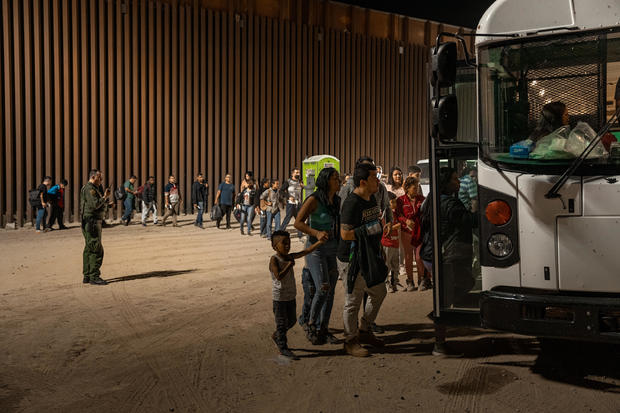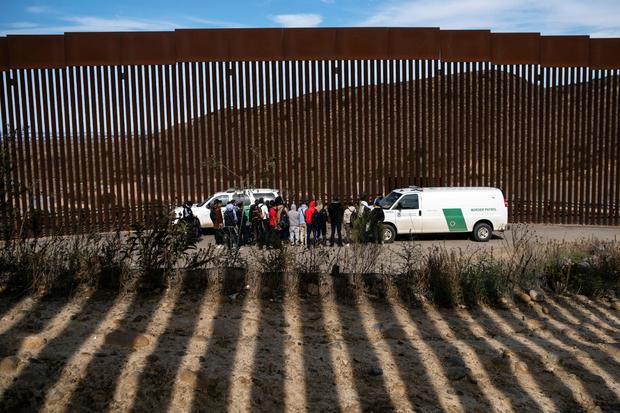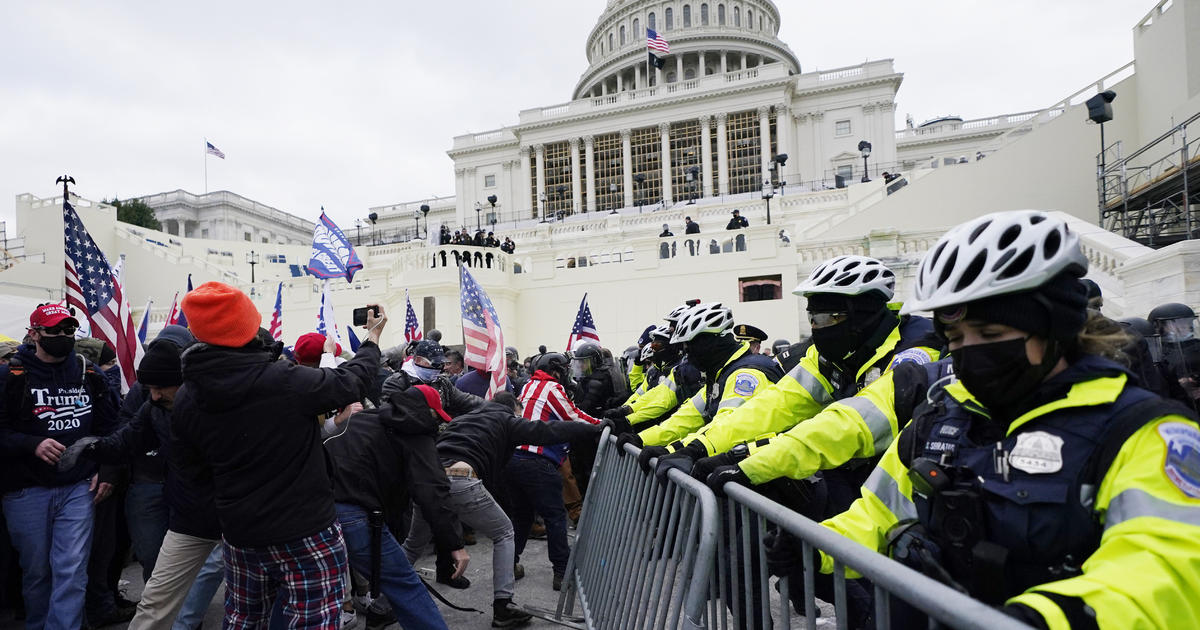What is Title 42, the COVID border policy used to expel migrants?
A pandemic-era measure known as Title 42 that allowed the U.S. to expel hundreds of thousands of migrants on public health grounds has become the latest flashpoint in a contentious national debate over how officials should process those arriving along the southern border.
After defending it for over a year, the Biden administration sought to end Title 42 in the spring of 2022, pointing to the improving pandemic environment and drop in coronavirus infections, but a coalition of Republican-led states convinced a federal court to block the policy's termination on procedural grounds.
Then, in November, a federal judge in Washington, D.C., declared Title 42 illegal, saying the government had not sufficiently explained the public health justification for the measure or considered its impact on asylum-seekers.
But the same group of Republican-led states that managed to halt Title 42's termination in the spring of 2022 convinced the Supreme Court in December to delay the policy's end once again until the justices decide whether the states should be allowed to defend the expulsions in court.
What exactly is Title 42, and how has it been used by the current and previous U.S. administrations to expel migrants? Here are the facts.
What is Title 42, and how did it start?
On March, 20, 2020, at the outset of the COVID-19 public health emergency, Trump previewed a measure to curb "mass uncontrolled cross-border movement," a move that would ultimately go further in restricting migration than any of his administration's previous hardline border policies.
That day, Centers for Disease Control and Prevention (CDC) Director Robert Redfield invoked a World War II-era public health law to authorize U.S. border officials to expel migrants. The law, found in Title 42 of the U.S. code, grants the government the "power to prohibit, in whole or in part, the introduction of persons and property" to stop a contagious disease from spreading in the U.S.
The order Redfield signed said the expulsions were necessary to control the spread of COVID-19 in border facilities, protect U.S. agents from the virus and preserve medical resources. While Redfield's initial order was enacted for 30 days, he extended it for another month in April 2020 and then indefinitely in May 2020.
Despite its stated public health justification, the CDC order authorizing the deportations was signed over the objection of top experts at the agency who did not believe the unprecedented policy was justified, according to congressional testimony and CBS News reporting.
Officials refer to a deportation under Title 42 as an "expulsion" since it is not carried out under immigration law, which imposes further penalties on those who are removed, such as multi-year banishments from the U.S.
How do the expulsions work in practice?
On paper, a Title 42 expulsion is supposed to occur soon after migrants are taken into custody, since the stated objective is to minimize the chances of them spreading the coronavirus inside U.S. detention facilities.
Most migrants processed under Title 42 have been expelled by land to Mexico, and that process can take just a few hours. However, the Mexican government has only formally agreed to accept the return of expelled migrants if they are Mexican, Guatemalan, Honduran or Salvadoran. In October, Mexico began accepting expelled Venezuelans.
A smaller number of migrants are expelled through deportation flights, usually to their home countries. The U.S. has expelled some migrants to Brazil, Colombia, the Dominican Republic, Ecuador, El Salvador, Guatemala, Haiti, Honduras, Nicaragua and southern Mexico by air, though some of those operations have been discontinued.
In September 2021, the Biden administration launched the largest Title 42 air expulsion blitz to date, expelling thousands of deportees to Haiti after the sudden arrival of thousands of migrants from the Caribbean country in Del Rio, Texas.
The Biden and Trump administrations have argued that Title 42 supersedes U.S. asylum law, which allows migrants on U.S. soil to seek protection, regardless of their legal status. Hence, those processed under Title 42 are not allowed to file an application for asylum as a means to stop their expulsion.
Only an extremely limited number of migrants processed under Title 42 are screened for a lesser form of protection if they make "an affirmative, spontaneous and reasonably believable claim that they fear being tortured in the country they are being sent back to," as outlined in internal DHS guidance.
How many migrants have been expelled?
Since March 2020, U.S. authorities along the border with Mexico have carried out more than 2.4 million migrant expulsions under Title 42, according to government statistics.
While Title 42 applies to both land borders, U.S. officials along the Canadian border, who process a substantially lower number of migrants compared to their southern border counterparts, have used the policy on a limited basis.
Title 42 expulsions do not represent the number of people expelled because some migrants, primarily single adults, are expelled multiple times. The expulsions have fueled an unusually high rate of repeat border crossings by migrants expelled to northern Mexico, because they do not carry legal consequences.
In nine months, the Trump administration carried out over 400,000 Title 42 expulsions along the southern border. During Mr. Biden's tenure, U.S. border authorities have carried out over 2 million expulsions, an analysis of Customs and Border Protection (CBP) data shows.
While the Biden administration has carried out more expulsions than the Trump administration, Mr. Biden has also enforced Title 42 longer and faced a record number of migrant arrivals along the southern border.
How has Title 42 changed under Biden?
Between March 2020 and January 2021, when the Trump administration enforced Title 42, U.S. border officials recorded 552,919 migrant encounters, 83% of which resulted in expulsions. During the Biden administration, the U.S. has reported more than 4 million migrant encounters, roughly half of which turned into Title 42 expulsions, according to government data as of the end of October 2022.
Like the Trump administration, Biden officials have used Title 42 to expel most migrant adults traveling without children. Approximately two-thirds of the 2.7 million U.S. border encounters with single adults under the Biden administration have led to a Title 42 expulsion, CBP statistics show.
The Trump administration expelled 69% of the migrant families who entered U.S. border custody between March 2020 and January 2021. Conversely, during Mr. Biden's tenure, border agents have expelled roughly 20% of migrant parents and children processed as families.
But more than 1 million parents and children traveling as families have entered U.S. border custody during Mr. Biden's tenure, compared to 25,790 during the time the Trump administration enforced Title 42.
Under Mr. Biden, Mexican officials along some of the busiest parts of the border refused to accept migrant families with young children. Over the past year, U.S. border authorities also encountered record numbers of Venezuelans, Nicaraguans and Cubans, who generally can't be expelled to Mexico or their home countries.
The Biden administration has declined to revive the Trump practice of using Title 42 to expel unaccompanied children. The Trump administration expelled nearly 16,000 unaccompanied minors before a federal judge in November 2020 halted the practice, finding it unlawful.
What happens to migrants who are not expelled?
Most unaccompanied children are transferred to shelters overseen by the Department of Health and Human Services, which is responsible for their care until it can place them with sponsors, who are typically family members living in the U.S.
Since the Biden administration discontinued family detention, most migrant families with children who are not expelled are released with instructions to check-in with immigration officials or a notice to appear in an immigration court, where they can seek asylum. However, that process can take years, due to the immigration court system's backlog of 2 million unresolved cases.
Some families could also be quickly deported to their home country under a process known as"expedited removal" if they do not pass initial asylum screenings or if border officials determine that they did not ask for asylum.
Single adult migrants who are not expelled under Title 42 are typically sent to immigration detention facilities or deported under expedited removal. In some cases, single adult migrants are released with court notices or instructions to check in with immigration officials in their respective destinations.
What is the future of U.S. border policy after Title 42?
One Title 42 is lifted, the U.S. will need to process all migrants under U.S. immigration law, which allows them to seek asylum as a way to try to stop their deportation.
The U.S. will still be able to quickly deport some migrants under the expedited removal process if they do not ask for asylum or if they fail to establish credible fear of persecution. But the U.S. will continue to face difficulty in conducting large-deportations to countries like Cuba, Nicaragua and Venezuela that limit or outright reject U.S. deportations of their citizens.
The Biden administration has said it is preparing for Title 42's end by surging personnel and resources to the southern border; increasing migrant processing capacity; expanding its use of expedited removal and prosecutions for certain migrants; enhancing its collaboration with groups that assist asylum-seekers; cracking down on human smugglers; and enlisting the help of other countries in the Western Hemisphere to reduce U.S.-bound migration.
The administration has also been considering adopting certain policies designed to deter migration, including an asylum restriction that would render migrants ineligible for U.S. protection if they did not ask for refuge in other countries first.






